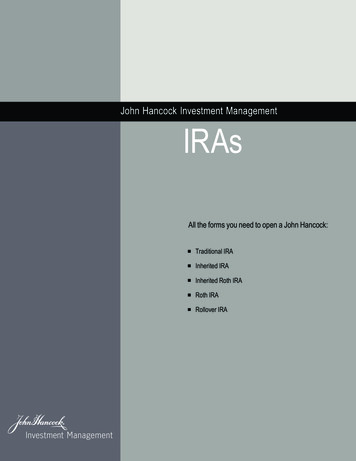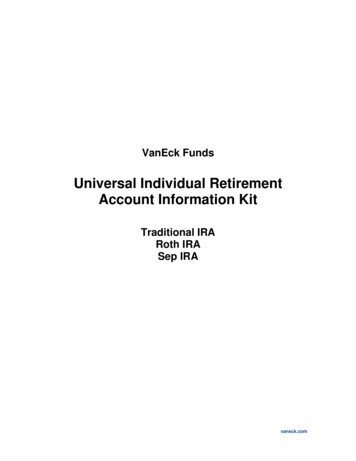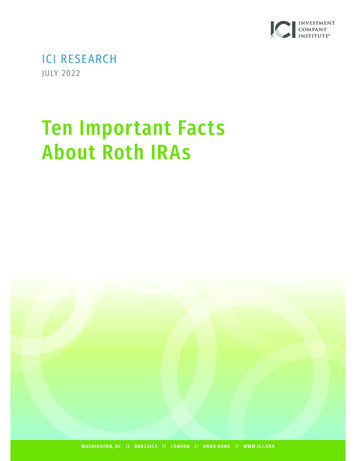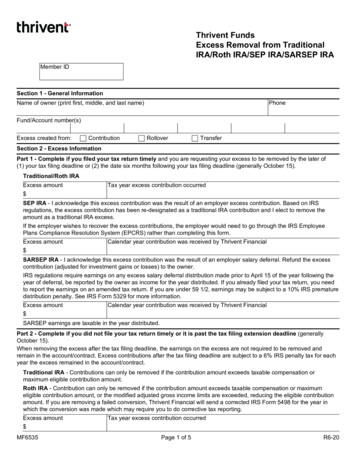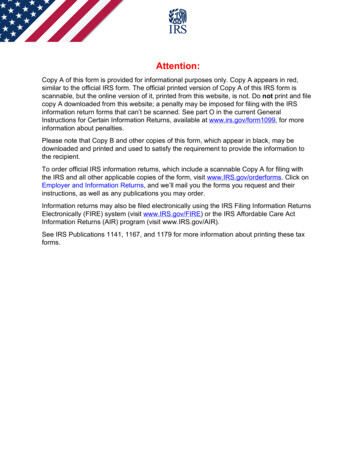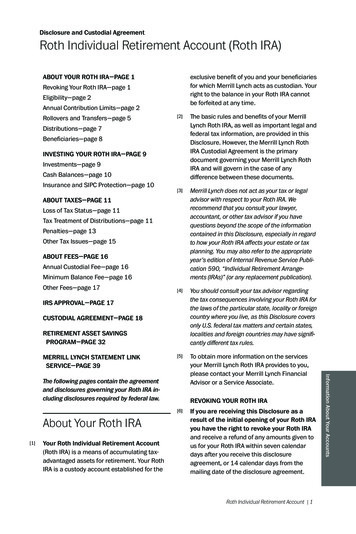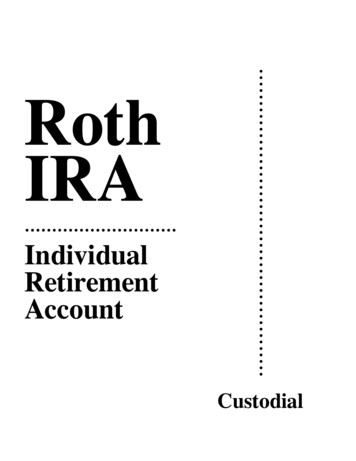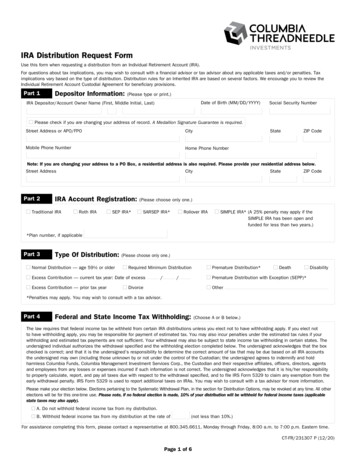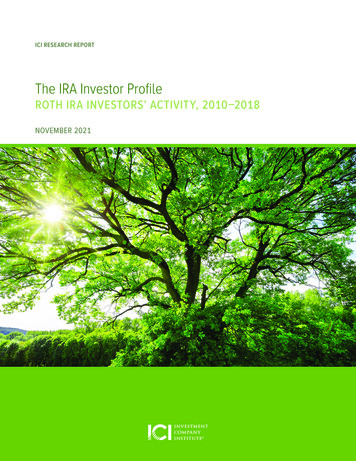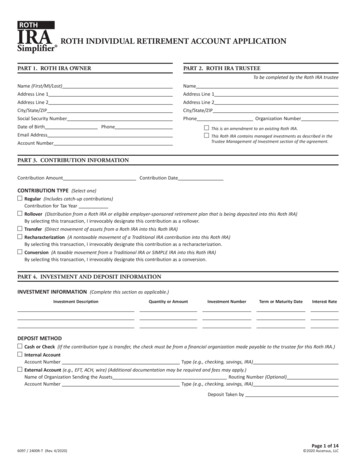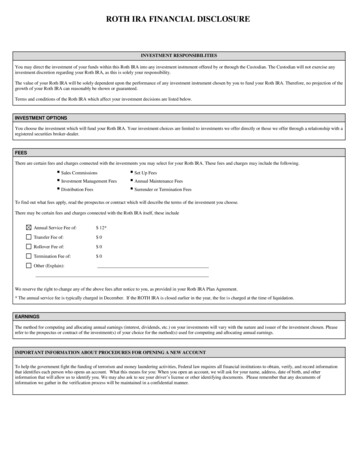
Transcription
Traditional &Roth IRACustodial agreementsand disclosure statementProtect your future
Traditional/Roth IRA custodial agreementsTraditional/Roth IRA Custodial Agreements . . . . . . . . . . . . . 1Traditional/Roth IRA Disclosure Statement. . . . . . . . . . . . . 36This Agreement governs your Traditional IRA or Roth IRAwith U.S. Bancorp Investments. We serve as the custodian ofyour Account.To open a new Account for a Traditional IRA or Roth IRA,you must complete and sign an Application and return it tous. If this Agreement amends your existing Account, youroriginal Application remains in effect.In this Agreement, “you” and “your” refer to the individualwho has signed the Application to become a Participant in theTraditional IRA or Roth IRA. “We,” “us,” and “our” refer to thefinancial organization designated as Custodian in the Application.TABLE OF CONTENTSSec. fied AGIParticipantRoth IRASIMPLE IRASponsorSpouseTraditional IRAYearSec. 2CONTRIBUTIONSContributions to AccountTraditional IRA and Roth IRARollover ContributionsTransfer ContributionsSEP IRACorrection of Excess ContributionsAllocation of ResponsibilityABO-IRAsSec. 3INVESTMENTSInvestment Management ChoicesInvestments GenerallyProhibited TransactionsAllocation of ResponsibilityLegal Incapacity of ParticipantSec. 4BENEFITSGeneral Rule and DeadlineBenefits Before Age 59½Benefits Between Ages 59½ and 70½Benefits Over Age 70½Death BenefitsAllocation of ResponsibilityInvestment and insurance products and services including annuities are:NOT A DEPOSIT NOT FDIC INSURED NOT GUARANTEED BY THE BANK MAY LOSE VALUE NOT INSURED BY ANY FEDERAL GOVERNMENT AGENCYU.S. Wealth Management – U.S. Bancorp Investments is a marketing logo forU.S. Bancorp Investments.Investment and insurance products and services including annuities are availablethrough U.S. Bancorp Investments, the marketing name for U.S. BancorpInvestments, Inc., member FINRA and SIPC, an investment adviser and abrokerage subsidiary of U.S. Bancorp and affiliate of U.S. Bank.This material is based on data obtained from sources we consider to be reliable.It is not guaranteed as to accuracy and does not purport to be complete. Thisinformation is not intended to be used as the primary basis of investmentdecisions. Because of individual client requirements, it should not be construedas advice designed to meet the particular investment needs of any investor. It isnot a representation by us or an offer or the solicitation of an offer to sell or buyany security. Further, a security described in this publication may not be eligiblefor solicitation in the states in which the client resides.U.S. Bancorp Investments and its representatives do not provide tax or legal advice.Each individual’s tax and financial situation is unique. You should consult your taxor legal advisor for advice and information concerning your particular situation.U.S. Bancorp Investments can assist clients with IRA Rollovers. However, keepin mind that a rollover of qualified plan assets into an IRA is not your only option.Before deciding whether to keep assets in your current employer’s plan, to rollassets to a new employer’s plan, to take a cash distribution, or to roll assets intoan IRA, clients should be sure to consider potential benefits and limitations ofall options. These include total fees and expenses, range of investment optionsavailable, penalty-free withdrawals, availability of services, protection fromcreditors, RMD planning and taxation of employer stock. Discuss rollover optionswith your tax advisor for tax considerations.1
Sec. 5Sec. 6Sec. 7Sec. 8Sec. 9BENEFICIARIESDesignation of BeneficiariesAutomatic BeneficiaryRules for Interpreting DesignationsAdministration of Beneficiary’s AccountDisclaimers by BeneficiaryAllocating ResponsibilitySECTION 1: DEFINITIONS1.1. Account.“Account” means each separate custodial account we establishand maintain for you as a Traditional IRA or Roth IRA underthis Agreement. The account is credited with contributionsmade by or for you under this Agreement and adjusted for anyincrease or decrease.NATURE of ACCOUNTAccount AssetsVestingNo ComminglingExclusive BenefitAlienation or Assignment of AccountWe will maintain separate Accounts for you for:ADMINISTRATIVE POWERS and DUTIESGeneral PowersConfirmations and DocumentsLiquidation of InvestmentsProtection of Custodian and Broker-DealerAfter your death, we will establish a separate Account for eachBeneficiary’s share of your Account.INFORMATION and REPORTSYour DutiesOur DutiesOur RecordsValuation of AccountsOur ReportsFEES, EXPENSES and TAXESIn GeneralTax WithholdingFinal PaymentSec. 10 CHANGE of CUSTODIANChangeSubstitutionQualification of SuccessorPayment to SuccessorSuccessor OrganizationsSec. 11 AMENDMENT or TERMINATION of AGREEMENTPower to AmendLimitation on AmendmentsTerminationTransferSec. 12 MISCELLANEOUSInitial Adoption or RevocationNoticesStatutory and Other ReferencesCommunity and Marital Property LawsGoverning LawDuplicatesPrivacy Pledge and Information SharingEffective Date2(a) Contributions to your Traditional IRA(b) Contributions to your Roth IRA(c) Rollover or transfer contributions you designate for aseparate Account1.2. Agreement.“Agreement” means this custodial agreement, as amended fromtime to time.1.3. Application.“Application” means an application form used by you andaccepted by us under this Agreement.1.4. Beneficiary.“Beneficiary” means the person or persons you have designatedor otherwise specified under Section 5 of this Agreement.1.5. Benefits.“Benefits” mean the balance of your Account or, after yourdeath, the separate Account of each Beneficiary.1.6. Broker-Dealer.“Broker-Dealer” means the following financial organizationthat is designated in the Application as the Broker-Dealer foryour Account:(a) U.S. Bancorp Investments, Inc.(b) As permitted by the Custodian, any other registeredBroker-Dealer whether or not affiliated with U.S. Bancorp.1.7. Code.“Code” means the Internal Revenue Code of 1986, includingapplicable regulations for the specified section of the Code.1.8. Compensation.“Compensation” means wages, salaries, professional fees, orother amounts derived from or received for personal servicesactually rendered (including, but not limited to, commissionspaid salespersons, compensation for services on the basis ofa percentage of profits, commissions on insurance premiums,tips, and bonuses).3
If you are self-employed, compensation includes earnedincome as defined in Code section 401(c)(2) (reduced by thededuction you take for contributions made to a self-employedretirement plan). For purposes of this definition, Codesection 401(c)(2) is applied as if the term trade or business forpurposes of Code section 1402 included service described insubsection (c)(6).Compensation does not include amounts derived from orreceived as earnings or profits from property (including,but not limited to, interest and dividends) or amounts notincludible in gross income. Compensation also does notinclude any amount received as a pension or annuity or asdeferred compensation.Compensation includes any amount includible in your grossincome under Code section 71 with respect to a divorce orseparation instrument described in subparagraph (A) of Codesection 71(b)(2). Compensation also includes combat zonecompensation that is excluded from income for federal incometax purposes under Code section 112.If you are married filing a joint return, the greatercompensation of your spouse is treated as your owncompensation, but only to the extent that such spouse’scompensation is not being used for purposes of the spousemaking a contribution to a Roth IRA or a deductiblecontribution to a Traditional IRA.1.9. Custodian.“Custodian” means the following financial organization thatis designated in the Application as the Custodian for yourAccount:(a) U.S. Bank National Association; or(b) Any other financial organization affiliated with U.S. Bankwhich is either a “bank” as defined in Code section408(n) or a business entity with Internal Revenue Serviceauthorization under Code section 408(h) to serve ascustodian. The address for the Custodian is in theApplication for your Account.1.10. Modified AGI.“Modified AGI” means your modified adjusted gross incomefor a year, as defined in Code section 408A(c)(3)(C)(i), butnot including any amount included in adjusted gross incomeas a result of a rollover from a Traditional IRA (or, beginningin 2009, from an eligible retirement plan described in Codesection 402(c)(8)(B)) to a Roth IRA (a “conversion”).1.11. Participant.“Participant” means you, the individual who signedthe Application.1.12. Roth IRA.“Roth IRA” means an individual retirement plan (as definedin Code section 7701(a)(37)) designated at the time it is4established as a Roth IRA under Code section 408A. Thedesignation must be made in the manner prescribed by theSecretary of Treasury under Code section 408A(b).1.13. SIMPLE IRA.“SIMPLE IRA” means an individual retirement plan (asdefined in Code section 7701(a)(37)), that is used inconjunction with a SIMPLE IRA plan established by anemployer pursuant to Code section 408(p).1.14. Sponsor.“Sponsor” means U.S. Bank National Association.1.15. Spouse.“Spouse” means the person to whom you are legally married,as determined under federal tax law.1.16. Traditional IRA.“Traditional IRA” means an individual retirement plan (asdefined in Code section 7701(a)(37)) which is not a Roth IRAor a SIMPLE IRA.1.17. Year.“Year” means the calendar year or other taxable year of theParticipant or beneficiary(ies) for federal income tax purposes.SECTION 2: CONTRIBUTIONS2.1. Contributions to Account.All contributions we receive on your behalf under thisAgreement will be credited to your Account.2.2. Traditional IRA and Roth IRA.If you or your spouse receives compensation during the year,you may contribute to your own Account for the year or tothe separate Account of your spouse if you are married and filea joint tax return according to the following rules:(a) Amount. Your total contributions may never exceed 100%of your compensation for the year. If you are under age50, your total contributions for the year may not exceed 5,500 for years beginning in 2013 and 2014. If you are age50 or older, your total contributions for the year may notexceed 6,500 for any year beginning in 2013 and 2014.After 2014, the contribution limits will be adjusted by theSecretary of the Treasury for cost-of-living increases underCode Section 219(b)(5)(D) in multiples of 500. If you are married, both you and your spouse may makecontributions for the year up to the limits specified aboveso long as the contributions do not exceed 100% of thecombined compensation for the year of you and yourspouse. However, the most that can be contributed toeach Account is the limit specified above for the year inwhich the contribution is made.5
If you have made any contributions for the year to aspecial pre-June 25, 1959 pension plan under Code section501(c)(18), the amount you may contribute to the Accountfor the year will be reduced by the amount of suchcontributions.(b) Phase-Out of Maximum Amount for Roth IRAs. The annual limit for contributions to Roth IRAs isgradually reduced to 0 between certain levels ofModified AGI as provided in Code section 408(A)(c). For2013, if you are single or head of household, the annualcontribution limit is phased-out between Modified AGIof 112,000 and 127,000. For 2013, if you are a qualifyingwidow(er) or married filing a joint tax return, the annualcontribution limit is phased-out between Modified AGIof 178,000 and 188,000. If you are married filing aseparate return, the contribution is phased-out betweenModified AGI of 0 and 10,000. After 2013, the phaseout amounts above will be adjusted by the Secretary of theTreasury for cost-of-living increases under Code section408A(c)(3), in multiples of 1,000.(c) Form. All contributions must be in the form of a checkor debited in cash from a linked bank account or debitedin cash from a U.S. Bancorp Investments, Inc. brokerageaccount.(d) Maximum Age. You cannot contribute to yourTraditional IRA for the year in which you attain age70½ or thereafter (except for rollover contributions andtransfers). However, this maximum age limitation doesnot apply to Roth IRAs.(e) Time. The contribution for the year may be made in oneor more payments at any time from the first day of theyear until the date prescribed by the law for filing yourfederal income tax return for the year (not includingextensions thereof ). You must include a written noticewith each payment indicating the year for which it ismade. In the absence of such notice, we will presume thepayment is made for the year in which we receive it.(f ) Contributions from Alimony. All taxable alimony orseparate maintenance payments you receive during theyear under a decree of divorce or separate maintenanceor a written instrument incident to such a decree willbe treated as compensation in determining the amountwhich may be contributed to your Account for the year.(g) Recharacterization. A contribution to a Traditional IRAmay be recharacterized pursuant to the rules in section1.408A-5 of the Income Tax Regulations as a contributionto a Roth IRA, subject to the limits in (b) above.(h) SIMPLE IRA Limits. You cannot contribute to eithera Traditional IRA or a Roth IRA under a SIMPLE IRAplan established by an employer pursuant to Code section408(p). Also, no transfer or rollover of funds attributable6to contributions made by a particular employer under itsSIMPLE IRA plan can be made to either a TraditionalIRA or a Roth IRA from a SIMPLE IRA prior to theexpiration of the 2-year period beginning on the date youfirst participated in that employer’s SIMPLE IRA plan.(i) Special Rules. Notwithstanding the limitations in (a) or(b) above, certain special rules apply. Notwithstanding thedollar limitations in (a) above, you may make a repaymentcontribution of a quali- fied reservist distributiondescribed in Code section 72(t)(2)(G) during the 2-yearperiod beginning on the day after the end of the activeduty period. If you have received (i) a military death gratuity (under 10United States Code 1477) or (ii) Servicemembers’ GroupLife Insurance, you may contribute such amounts to yourRoth IRA (but not a Traditional IRA), even if you are nototherwise eligible to make Roth IRA contributions due toincome levels or the annual contribution limits. The contribution must be made to the Roth IRA beforethe end of the one-year period beginning on the dateon which you received the military death gratuity orServicemembers’ Group Life Insurance payment. Inaddition, the amount contributed cannot exceed thetotal such amounts you received in the one-year periodreduced by the amounts so received that you contributedto another Roth IRA or a Coverdell Education SavingsAccount. Certain payments by a commercial passenger airlinecarrier to its employees or former employees whoparticipated in the carrier’s defined benefit pension plancan be contributed to an IRA (subject to applicablelimits for transfers to a Traditional IRA under the 2012FAA Modernization Act), even if the individual is nototherwise eligible to make a deductible Traditional IRAcontribution or a Roth IRA contributions due to incomelevels or the annual contribution limits.2.3. Rollover Contributions.In addition to the contributions otherwise permittedunder this Section 2, you may make a rollover contribution(including a direct rollover) to your own Account of cashor, with our prior consent, other assets, provided thatyou determine that the contribution is attributable to adistribution from an individual retirement plan or a qualifiedemployer or government plan and meets the requirementsdescribed in Code section 402(c), 403(a)(4), 403(b)(8), 403(b)(10), 408(d)(3), 408A(c)(6), or 457(e)(16).You may make a rollover contribution (including a directrollover) to a Roth IRA (but not to a Traditional IRA) of adistribution from a designated Roth contribution accountdescribed in Code section 402A, as provided in Code section408A(c)(6).7
Prior to January 1, 2010, a rollover from a Traditional IRA orfrom an eligible retirement plan described in Code section402(c)(8)(B) (other than of designated Roth contributionsdescribed in Code section 402A) could not be made to a RothIRA if for the year the amount is distributed from the otherplan or IRA (i) you are married and file a separate return,(ii) you are not married and have Modified AGI in excessof 100,000 or (iii) you are married and together you andyour spouse have Modified AGI in excess of 100,000. As ofJanuary 1, 2010, these limitations ceased to apply.If you make a written request at the time of the contribution,we will establish a separate Account for you consisting only ofthat rollover contribution and earnings on it.2.4. Transfer Contributions.In addition to the contributions otherwise permitted underthis Section 2, you may direct us to accept for deposit intoyour Account a check, or with our prior consent, other assetstransferred directly to us from a custodian or trustee (or otherfunding agent) of an individual retirement plan or a qualifiedemployer or government plan, provided you determinethat such cash or other assets are eligible for transfer to anindividual retirement plan.If you make a written request at the time of the transfer, wewill establish a separate Account for you consisting only ofthat transfer contribution and earnings on it.If the transfer includes after-tax contributions, it is yourresponsibility to keep track of and report to the IRS theamount of these after-tax contributions.2.5. SEP-IRA.In addition to the contributions otherwise permitted underthis Section 2, your employer (including a self-employedindividual) may make simplified employee pension (as definedin Code section 408(k)) (“SEP”) contributions for the year toyour Traditional IRA according to the following rules:(a) Amount. The employer will determine the amount (ifany) to be contributed to your Account for the yearunder the written allocation formula it has adopted. Theemployer’s total contributions to your Account for theyear may not exceed the lesser of:(1) 51,000 (or any larger limitation in effect under Codesection 415(c)(1)(A)), or(2) 25% of your compensation for that year from theemployer (as limited under Code section 408(k)(3)(C)).For this purpose, compensation (i) does not include anyelective deferrals which are not includible in your grossincome under Code sections 125, 132(f )(4), 401(k), 402(h)(1)(B), 403(b), or 457 and (ii) is determined without regard to theemployer’s SEP contributions, except as specified in Section1.8 for self-employed individuals.8(b) Form. All SEP contributions must be in the form of cashor check.(c) No Maximum Age. There is no maximum age limitationon SEP contributions.(d) Time. The SEP contributions for the year may be madein one or more payments at any time from the first dayof the year until the date prescribed by law for filingthe Participant’s federal income tax return for the year(including extensions thereof ). The employer mustinclude a written notice with each payment indicating theyear for which it is made. In the absence of such notice,we will presume the payment is made for the year inwhich we receive it.(e) Roth IRAs. SEP contributions cannot be made toRoth IRAs.2.6. Correction of Excess Contributions.You are subject to a penalty tax on an excess contribution foreach year the excess contribution is not corrected.(a) Timely Correction. To avoid the penalty tax for anyyear, the amount of the excess contribution plus any netincome attributable to it must be withdrawn by you onor before the date prescribed by law (including extensionsof time) for filing your federal income tax return forthe year. No tax deduction may be taken for the excesscontribution. If such a withdrawal is made, the netincome (if any) attributable to the excess contribution issubject (unless an exception applies) to a penalty tax onpremature distribution before age 59½. If we receive a timely written notice from you specifyingthe amount of an excess contribution, we will distributeto you from the Account the amount of the excesscontribution plus the net income (if any) attributable to it.(b) Late Correction. If an excess contribution is not timelycorrected as described in (a) above, the penalty tax onthe excess contribution continues for each year the excesscontribution is not corrected. If after the deadline in (a) above, you give us a writtennotice specifying the amount of the excess contribution,we will, at your election, either (i) distribute the amountof the excess contribution to you from the Account, or (ii)subject to the limitations in Sections 2.2, 2.3, and 2.5, treatthe amount of the excess contribution as if it were a cashcontribution by or for you for the current year. The excess contribution distributed under (i) above issubject (unless an exception applies) to a penalty tax onpremature distribution before age 59½.9
2.7. Allocation of Responsibility.Your employer will not make a contribution to your Accountunder Section 2.2 for any year unless the contribution is in theform of cash or check and does not exceed the dollar limit thatapplies to you for that year as set forth in Section 2.2.You, or anyone on your behalf, will not make a SEPcontribution to your Account under Section 2.5 for anycalendar year unless the contribution is in the form of cash orcheck and does not exceed 51,000 (or any larger limitation ineffect under Code section 415(c)(1)(A)).We do not have any duty to question, investigate, or giveadvice with respect to the amount, form, timeliness, taxeffect, or any other aspect of any contribution or any returnof an excess contribution. All such matters are your exclusiveresponsibility. Our responsibility is limited to holding andadministering in accordance with the terms of this Agreementthe contributions we actually receive.2.8. ABO-IRAs.This Agreement may be used by a non-spouse beneficiary onor after January 1, 2007, to establish an “As Beneficiary Of ”IRA with funds from an eligible retirement plan described inCode section 402(c)(8)(B). This type of ABO- IRA must beestablished by a direct transfer as described in Section 2.4. Noother contributions are allowed to an ABO-IRA.SECTION 3: INVESTMENTS3.1. Investment Management Choices.You may choose between the following types of investmentmanagement for your Account on the Application and bycompleting any required additional investment advisoryagreements. You may change your selection at any time byproviding us with written notice in a form acceptable to us.(a) Self-Directed Investments. You will direct us withrespect to the investment of all contributions in yourAccount and the earnings on them. You will control andmanagement the investment of the Account in your owndiscretion. If you prefer not to manage your Account,you may authorize another individual to give investmentdirections to us. All investment directions must bedelivered to us in such manner as we may require.(b) Investment Advisory Management. We will providesuch investment related services as stated in the applicableinvestment advisory agreement entered into between youand us. We may have such discretion, power or authority(if any) regarding the investment, reinvestment ordisposition of the Account as provided in such investmentadvisory agreement and our duties and liabilities arelimited accordingly.The investment management selection in place at the time ofyour death will continue until such time as changed by thebeneficiary(ies).103.2. Investments Generally.(a) Limitations. Investment directions are limited toinvestments available through us or the Broker-Dealer inthe regular course of business. Also, under Code sections408(a)(3) and 408(m), no part of the Account may beinvested in life insurance contracts or “collectibles” (thatis, any work of art, rug or antique, metal or gem, stampor coin, alcoholic beverage, or any other similar tangiblepersonal property which has been designated as collectibleby the Secretary of the Treasury), with exceptions to allowinvestment in (i) gold, silver, and platinum coins issued bythe United States, (ii) coins issued under state laws, and(iii) gold, silver, platinum, or palladium bullion meetingor exceeding the quality standards for delivery underregulated futures con- tracts. Transactions in options,coins, precious met- als, limited partnerships, andcertain other investments are limited or prohibited underbusiness policies we have established, which policies aresubject to change from time to time. Subject to those legaland business limitations, we will comply with all yourdirections.(b) Investment Risk. YOU UNDERSTAND THEFOLLOWING: INVESTMENT PRODUCTS,INCLUDING SHARES OF MUTUAL FUNDSSUCH AS THE FIRST AMERICAN FUNDS, ARENOT OBLIGATIONS OF OR GUARANTEEDBY ANY BANK, INCLUDING U.S. BANKNATIONAL ASSOCIATION AND/OR ANY OFITS AFFILIATES, NOR ARE THEY INSUREDBY THE FEDERAL DEPOSIT INSURANCECORPORATION (“FDIC”), THE FEDERALRESERVE BOARD, OR ANY OTHER AGENCY.AN INVESTMENT IN SUCH PRODUCTSINVOLVES INVESTMENT RISK, INCLUDINGPOSSIBLE LOSS OF PRINCIPAL.(c) Affiliates. As permitted by the Custodian, each personwho directs the Custodian under this Plan Documentshall be authorized and hereby retains the right to directthe Custodian to (i) retain the services of any registeredbroker-dealer organization that is currently or hereafterbecomes affiliated with U.S. Bank National Associationand any future successors in interest thereto (collectively,including U.S. Bank National Association and its otheraffiliates, for the purposes of this section referred to asthe “affiliated entities”), to provide services to assist in orfacilitate the purchase or sale of investment securities inthe Account, (ii) acquire as assets of the Account sharesof mutual funds to which affiliated entities provide fora fee, services in any capacity and (iii) acquire for theAccount any other services or products of any kind ornature from affiliated entities. The Custodian may be sodirected to retain one or more of the affiliated entitiesregardless of whether the same or similar services or11
products are available from other institutions. Pursuantto such directions, the Account may directly or indirectly(through mutual funds fees and charges, for example) paymanagement fees, transaction fees, and other commissionsto the affiliated entities for the services or productsprovided to the Account or such mutual funds at suchaffiliated entities’ standard or published rates withoutoffset (unless required by law) from any fees chargedby the Custodian for its services as Custodian. TheCustodian may also be so directed to deal directly withthe affiliated entities regardless of the capacity in which itis then acting to purchase, sell, exchange, or transfer assetsof the Account even though the affiliated entities arereceiving compensation or otherwise profiting from suchtransaction or are acting as a principal in such transaction.Included specifically, but not by way of limitation,among the transactions authorized by this provisionare transactions in which any of the affiliated entities isserving as an underwriter or member of an underwritingsyndicate for a security being purchased or is purchasingor selling a security for its own account.(d) FDIC. You understand the following: As permitted bythe Custodian, retirement bank deposits of U.S. BankNational Association (i.e., savings certificates and moneymarket retirement savings accounts) are FDIC insuredseparately from non-retirement deposits, up to legal limits.Other investment products are not FDIC insured, are notdeposits of, obligations of, or guaranteed by U.S. BankNational Association affiliate banks or other affiliates, andinvolve investment risks including possible loss of theprincipal invested.3.3. Prohibited Transactions.If you, your beneficiary(ies), or another “disqualified person”engages in a “prohibited transaction” with the Account(within the meaning of Code section 4975), the Account willlose its exemption for federal income tax purposes, and part orall of the assets of the Account (depending on the transaction)will be deemed distributed to you with a potential tax penaltyfor premature distribution before age 59½. Prohibitedtransactions include (but are not limited to) using the Accountas security for a loan, borrowing from the Account, sellingassets to the Account, and buying assets from the Account.3.4. Allocation of Responsibility.Except as provided in an investment advisory agreement, ourresponsibilities with respect to the investment of your Accountis limited to implementing the investment directions wereceive in proper form for the Account and to maintainingsafe custody for the assets of the Account. We have no dutyto question any investment direction we receive in the properform, to review the investments of the Account, or to makeany suggestions with respect to the investment of the Account.12We will not be liable for any tax or penalties imposedfor premature withdrawal or redemption of time depositcertificates or other investments, or loss of any kind whichmay result from any action taken pursuant to such investmentdirections or from any failure to act because of the absence ofsuch directions.3.5. Legal Incapacity of Participant.If you are a minor or otherwise legally disabled, then wemay require that any and all rights that could otherwise beexercised by you under the terms of this Agreement or at lawbe exercised on your behalf by your representative, and wemay rely on the authority and direction of such representativefor all actions taken with respect to the Account, including,without limitation:(a) Investing the Account as such representative may directin accordan
section 402(c)(8)(B)) to a Roth IRA (a "conversion"). 1.11. Participant. "Participant" means you, the individual who signed the Application. 1.12. Roth IRA. "Roth IRA" means an individual retirement plan (as defined in Code section 7701(a)(37)) designated at the time it is established as a Roth IRA under Code section 408A. The
